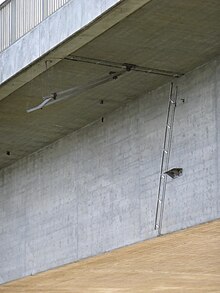Cutting charge
A cutting charge is a type of explosive device with a particularly high and targeted penetration force . It is used, for example, to cut through thick profile steel elements , massive girders or reinforced concrete parts . A normal explosive charge is not as effective as it is due to its poor directionality, as not enough directed energy is developed.
To sever a up to 1 m thick solid steel or reinforced concrete element a particular is for a velocity of detonation of the inserted explosive necessary, to the other is to obtain the directivity of a particular mechanical configuration of the snap landing necessary (similar in mode of action to one used in the military field hollow charge ), with which the effect is focused on a line.
construction
A cutting charge consists of a V-shaped metal body, the "liner". Highly explosive explosives have been applied to this along its entire length . There are different types of construction: one consists, for example, of two metal profiles , in the space between which the explosive is introduced.
Mode of action
When the charge is ignited, energy is released. This deforms the material of the cladding and, through the force of the explosion, turns it into a kind of projectile , which ultimately cuts through the steel.
The operating principle is similar to that of a shaped charge from the military sector. The difference is that the released energy is not concentrated on a single, very limited point, but on a linear, narrow surface. In this way, even the most solid steel construction can be quickly and specifically weakened with relatively little material and labor.
Bridges
Special variants with 7.5–9.0 kg per meter of cutting charge of highly explosive explosives are used in the military sector for “cutting through” bridges (steel and reinforced concrete). These cutting charges have a penetration force of up to 100 cm of reinforced concrete. In contrast to conventional blasting , the bridge is not completely destroyed, but is only destroyed when it is loaded, for example when trucks or tanks drive over it. The use of military cutting charges was reserved for the pioneers , but in the meantime they have also found their way into the demolition of buildings, preferably industrial plants. The types used by the Bundeswehr can be found in the list of Bundeswehr ammunition.
Applications
- Demolition of steel structures
- After being burned out, rocket stages are separated from the rest of the rocket with thin cutting charges during flight
- Cutting underground pipes in the gas and oil industry
Trade names
- Royal Ordnance Blade (no longer available)
- Linear cutter
- Semtex Razor from Explosia
- ResaFlex
Individual evidence
- ↑ The construction sites: Use of linear shaped charges , September 2008 edition, pages 42-44 (online PDF 1.01 MB) ( Memento from April 22, 2018 in the Internet Archive ), viewed on April 22, 2018
- ^ Pipe Recovery Systems. DynaEnergetics, accessed May 4, 2017 .
Web links
- Technical rule on explosives law Blasting work (accessed April 24, 2020)
- DE3739683C2 - Cutting charge (accessed April 24, 2020)
- Recycling of polymer composite structures from rotor blades (accessed April 24, 2020)
- Structural blasts (accessed April 24, 2020)
- Demolition specialist conference in Bauportal pp. 7, 8 (accessed on April 24, 2020)

